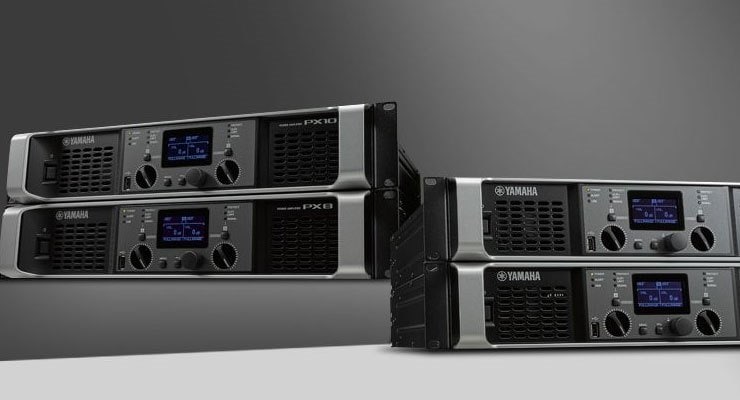What are power amplifiers?
Power amplifiers are devices that amplify electrical signals that have been adjusted to an appropriate volume and tone sent from the mixer, to a level that can be converted to acoustic sounds by the speakers. There are various types and models of power amplifier, varying in size, shape and output power, which are suited to different situations.
There are three major types of power amplifier, the characteristics of which are described below.

(1) Stand-alone power amplifiers
This is a general purpose type of power amplifier. Stand-alone power amplifiers amplify the signals sent from mixers to make the speakers produce sound. Several stand-alone power amplifiers can be installed together in racks, making it comparatively easy to build a large-scale PA system.

(2) Powered mixers (mixers with built-in power amplifiers)
This type of mixer includes a built-in power amplifier. Since the mixer and power amplifier which require a power supply are integrated into the PA system, only one power supply connection is required, and there are less connections to make than with stand-alone amplifiers.

(3) Powered speakers (speakers with built-in power amplifiers)
This type of speaker includes a built-in power amplifier. Since the built-in power amplifier is designed specifically for the speaker, the speaker and power amplifier combination feature superior compatibility, allowing the speaker to perform to the fullest. The mixer output can connect directly to the powered speaker, so there are less cables required.
<Note> Speakers that do not have a built-in power amplifier but require a stand-alone amp are called "passive speakers".
To build a PA system as easily and simply as possible, use either a powered mixer or powered speakers, which require fewer connections. However, stand-alone amplifiers offer a higher level of freedom, for expanding a system and for planning where to position the equipment.
Choosing power amplifiers
In this section, advice is given about choosing a power amplifier used in combination with passive speakers.
The output required by the power amplifier is determined by the number of speakers connected and their impedance. If the output from the amplifier exceeds the power rating of the speakers, the speakers could be damaged, so consider the amplifier-speaker combination before choosing the power amplifier.
Matching amplifiers with speakers
Using a Yamaha P3500S stand-alone power amplifier with Yamaha CBR10 passive speakers is a good example to see how an amplifier should match a speaker.
Listed on the P3500S spec sheet are several numbers according to the amplifier's output measurement conditions. When choosing a Yamaha amplifier, use the 20 Hz–20 kHz output as a reference for ordinary use.

P3500S power amplifier specifications (output)
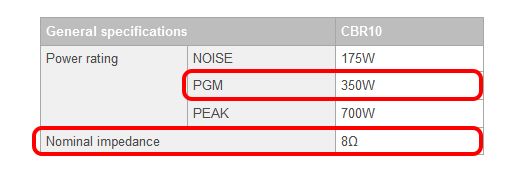
Next, when looking at a speaker's spec sheet, use the power rating PGM value and impedance value as a reference.
CBR10 passive speaker specifications
Since the P3500S power amplifier produces a 350W output with an 8-ohm impedance speaker, and the CBR10 speaker has a power rating (PGM) of 350W with an 8-ohm impedance, the power amplifier and speaker can be successfully used together.
Tips: It's not necessary for the PGM input value for the speaker and the power amplifier output value to be exactly the same. It's good to select a power amplifier output value of around 0.8 to 1.25 x speaker PGM value.
There are various ways of connecting the speakers and setting up the amplifiers, which can have an impact on impedance and available power. Continue reading for further advice.
Impedance of Speaker
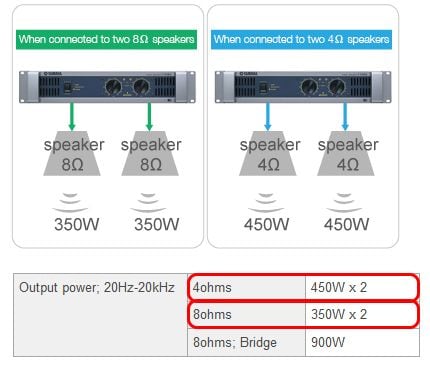
Impedance is a compound resistance value, and is represented as ohms (Ω). The greater the resistance, the harder it is for electricity to flow. Conversely, the less the resistance, the greater the flow of electricity. Even with the same power amplifier, the lower the impedance (ohms) of the speaker that is connected, the greater the number of watts output by the power amplifier.
A maximum of 350W output from each speaker (L-R) can be achieved when connecting 8-ohm speakers to the P3500S power amplifier, and a maximum of 450W output from each speaker (L-R) when connecting 4-ohm speakers.
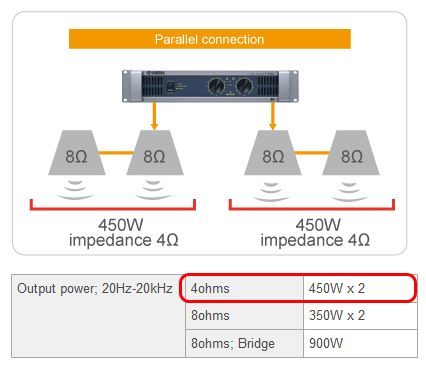
Connecting speakers in parallel
Almost all PA speakers can be easily connected to each other to expand the speaker setup. This kind of connection is called "parallel connection". When two speakers with the same impedance are connected in parallel, the total impedance is reduced by half. Therefore, the wattage output of a power amplifier which is connected to 8-ohm speakers in parallel will be the same as if a 4-ohm speaker was connected.
For example, if 8-ohm CBR10 speakers are connected in parallel, the impedance will be 4 ohms; and if these speakers are used with the P3500S, the output will be 450W.
<Note> be very careful before connecting three speakers in parallel to one amplifier output: three 8-ohm speakers together would have an impedance of less than 3ohms, which is not a safe value for most power amplifiers: it puts the equipment at risk of damage.
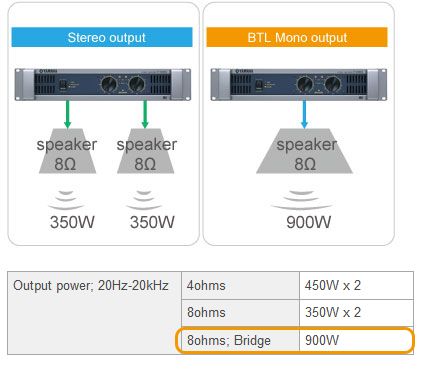
Power amplifier stereo and bridge connections
Almost all stand-alone power amplifiers feature stereo specs. However, if an amplifier is connected in bridged (BTL: Balanced Transformer Less) mode, it can be used as a single monaural amplifier. The output wattage will change in this mode.
The P3500S will deliver an output of 350W+350W when connected to two separate 8-ohm speakers. When bridged and used in monaural mode, the single PGM output will be appropriate for a 900W speaker at 8 ohms.
Amplifiers are often used in bridged mode to power large sub-woofer speakers.

